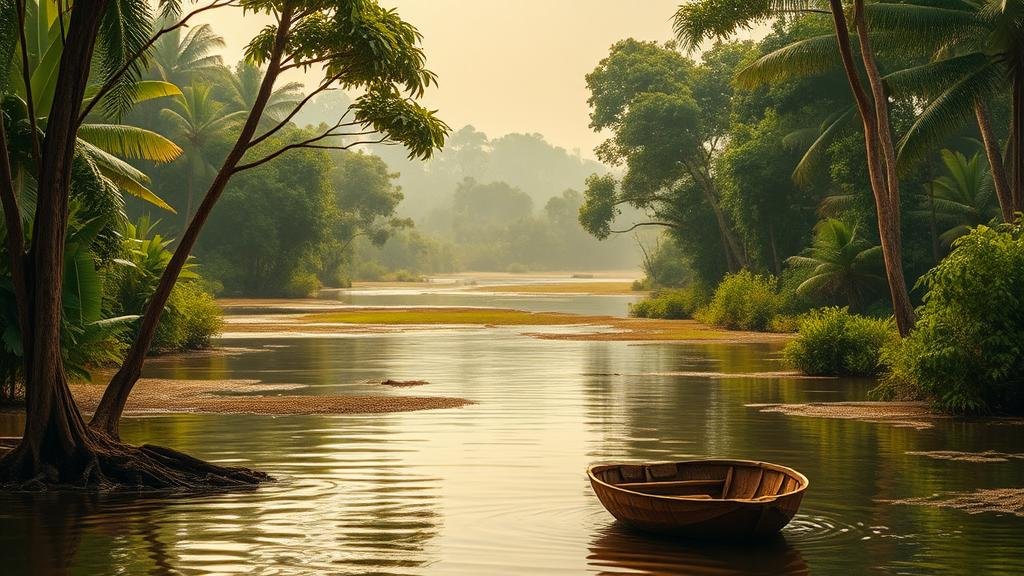The Jatunyacu River’s Gold: Tales of Discovery in the Amazon Basin
The Jatunyacu River’s Gold: Tales of Discovery in the Amazon Basin
Nestled deep within the lush rainforests of Ecuador, the Jatunyacu River flows serenely, its waters shimmering under the tropical sun. This river not only serves as a lifeline for local communities and wildlife but also harbors treasures that captivate mineral collectors and rockhounds alike. The allure of gold in its sands and the tales associated with its discovery make the Jatunyacu a fascinating subject of exploration for enthusiasts in the field.
The Geological Significance of the Jatunyacu
The Jatunyacu River is part of a significant geological province known for its rich mineral deposits. region’s formation is the result of ancient volcanic activity and subsequent erosion, which has given rise to various mineral-rich sedimentary layers.
Gold, often found in alluvial deposits along riverbeds, is typically concentrated in river systems due to hydraulic sorting. The average gold grade in river sediments, like those found in the Jatunyacu, can range from 0.1 to 4 grams per cubic meter, depending on specific locations and seasonal conditions.
Tales of Discovery
Stories about gold discovery along the Jatunyacu River date back centuries. Local indigenous tribes, such as the Kichwa, have known of the rivers wealth long before European explorers arrived. r traditional methods of gold extraction, which often include panning and using rudimentary sluice boxes, are still relevant today.
During the late 20th century, interest surged as amateur and professional miners flocked to the Jatunyacu in search of the fabled El Dorado. Artisanal mining has since gained popularity, with estimates suggesting that over 1,500 small-scale miners operate in the area, utilizing handmade tools and techniques that have been passed down through generations.
As globalization increases access to information, the Jatunyacus reputation as a gold-rich river has attracted attention from thrill-seekers and serious collectors. But, current mining practices raise several environmental concerns, particularly regarding deforestation and water pollution.
In response, several organizations are advocating for sustainable gold mining practices that preserve the ecosystem while still allowing for mineral collection. For example, the use of gravity separation techniques minimizes chemical use, thereby reducing harm to the surrounding environment. Also, reports claim that eco-friendly gold mining practices can yield around 12% more gold due to more efficient recovery methods.
Rockhounding in the Jatunyacu Area
For those interested in rockhounding in the Jatunyacu region, there are several key considerations:
- Permits: Ensure compliance with local regulations by obtaining necessary permits from both local authorities and indigenous groups.
- Tools: Essential tools for gold panning include a pan, a shovel, and a container for your collected material. Vulcanized rubber boots are recommended to navigate the often slippery riverbanks.
- Tides and Weather: The best time for exploration is during the dry season (June to September) when water levels drop, exposing more sediment.
Practical Tips for Collectors
Effective gold prospecting at the Jatunyacu River involves several strategies that maximize yield:
- Target specific locations: Downstream from tributaries or along bends where heavier materials settle can prove more productive.
- Observe natural indicators: Look for quartz veins and iron staining in rocks, which may indicate nearby gold deposits.
- Sample widely: Collect small samples from various locations and analyze them before committing extensive time and effort to one area.
Real-World Applications
Collectors may not only find physical treasures in the form of gold nuggets and flakes but also gain a deeper appreciation for the social and environmental dynamics of resource extraction. Understanding these factors can drastically influence choices around sustainable practices and conservation efforts in mineral collection.
Actionable Takeaways
The Jatunyacu River represents more than just a source of gold; it encapsulates the cultural history and ecological complexities of the Amazon Basin. For aspiring rockhounds and mineral collectors, this river offers a unique opportunity to engage in responsible collecting while contributing to the dialogue on sustainable practices in mining. Whether you are looking to strike gold or deepen your connection to this remarkable ecosystem, the journey along the Jatunyacus banks promises stories and discoveries worth savoring.



